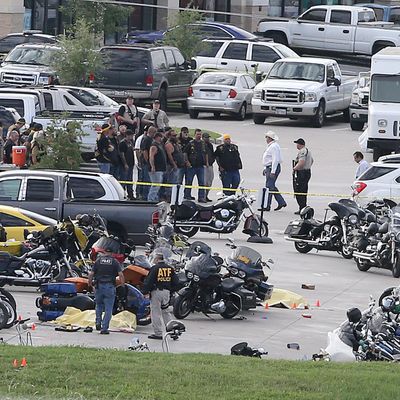
Yesterday in Waco, Texas, rival motorcycle gangs used the crowded parking lot of a big-box shopping center for a brutal gun battle that left 9 bikers dead and 18 hospitalized with gunshot and stab wounds. As reported by local news station KWTX, no bystanders or law enforcement officers were hurt, which is amazing considering that the fight started around noon in the bathroom of a popular chain restaurant where at least one of the gangs was holding a recruitment event.
The altercation, which allegedly began over a parking spot, started with fists but quickly escalated to chains, knives, and guns as the fight spilled out into the restaurant’s parking lot. Waco police officers, who were already on the scene under the presumption violence might occur between the nearly 200 gang members, then exchanged gunfire with the bikers. A patron of the restaurant said, “There were maybe 30 guns being fired in the parking lot, maybe 100 rounds.” Waco police sergeant W. Patrick Swanton added, “In 34 years of law enforcement, this is the most violent crime scene I have ever been involved in.”
Waco police report they confiscated at least 100 weapons from the bikers, some of which are seen below:
More social media from the scene as it unfolded:
In addition, Waco police indicated that the restaurant where the fight started, a Hooters-like sports-bar franchise called Twin Peaks, had welcomed these biker groups against the wishes of law enforcement officials, and that the restaurant’s managers had been uncooperative with police efforts to prevent this type of violence. If that proves to be true, Twin Peaks’ corporate parent will consider revoking the Waco location’s franchise agreement, according to a statement they gave the New York Times.
But just how prevalent are these self-labeled “outlaw motorcycle gangs”? Vox’s Libby Nelson looks into that:
Violent motorcycle gangs call themselves the “1 percent” — a defiant reference to a (possibly apocryphal) statement from the American Motorcycle Association that 99 percent of motorcyclists are law-abiding. There are hundreds of motorcycle gangs in the US, but the Department of Justice considers eight national groups to be a serious threat.
The gangs, which originated in the US but have spread abroad, are best known for trafficking in drugs and sometimes people. But they’re a relatively small part of the American gang landscape. A 2013 survey from the National Gang Intelligence Center found that about 2.5 percent of gang members nationwide are in outlaw motorcycle gangs.
Nelson also spoke with biker-gang expert Steve Cook, the director of the Midwest Outlaw Motorcycle Gang Investigators Association, who said this type of violence is usually over rival claims to territory:
A nine-year battle in Canada between rival gangs, known as the Quebec Biker Wars, left 160 people dead. In California in 2010, biker gangs fought over who would control a Starbucks in Santa Cruz, which led to gang members hitting each other with hammers in the parking lot.
Cook said Texas hasn’t historically been a hotspot for this kind of battle – at least, no more than anywhere else. But he said he’d seen signs that a confrontation was coming. Texas, he said, has historically been controlled by the Bandidos, one of the largest outlaw motorcycle gangs in the US. […] The Cossacks, a local Texas gang, had been challenging the Bandidos’ dominance, including discussing a possible alliance with the Hell’s Angels, a rival of the Bandidos, Cook said. The biggest provocation came when the Cossacks began wearing a Texas patch on their clothing – “basically a slap in the face to the Bandidos,” said Cook[.]
Looking at the biker jackets in photographs of the scene, as well as reporting from the Waco Tribune’s Olivia Messer, the Bandidos and Cossacks were indeed at the center of the fight, and three other allied gangs were present as well. The Bandidos are well known to the FBI, and their threat assessment of the gang indicates the bikers “are involved in transporting and distributing cocaine and marijuana and are involved in the production, transportation and distribution of methamphetamine.” As for the Cossacks, an eagle-eyed Twitter user noticed a different troubling detail about them:
However, it’s worth noting that these symbols do not necessarily mean the bikers are Nazi sympathizers, as the Anti-Defamation League has explained:
Decades ago, some outlaw biker gangs appropriated several Nazi-related symbols, including the SS bolts, essentially as shock symbols or symbols of rebellion or non-conformity. Thus SS bolts in the context of the outlaw biker subculture does not necessarily denote actual adherence to white supremacy. However, because there are a number of racists and full-blown white supremacists within the outlaw biker subculture, sometimes it actually is used as a symbol of white supremacy. Often the intended use and meaning of the SS bolts in this context is quite ambiguous and difficult to determine.
After a citywide crackdown on the suspected motorcycle gang members, the situation in Waco seemed under control late Sunday night. More than 100 bikers were subsequently detained at a local convention center, though it’s not yet known how many arrests will ultimately result from the deadly melee.






























